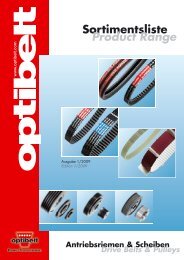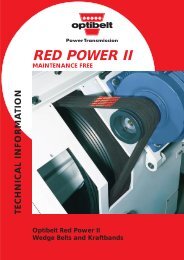You also want an ePaper? Increase the reach of your titles
YUMPU automatically turns print PDFs into web optimized ePapers that Google loves.
68<br />
Design hints<br />
Problems – Causes – Remedies<br />
Problems Causes Remedies<br />
Excessive wear on the loaded<br />
face of the belt tooth<br />
Excessive wear on the land<br />
between the belt teeth<br />
Exceptional wear on the<br />
belt sides<br />
Belt teeth shear off<br />
Excessive lateral runout<br />
Pulley flanges becoming detached<br />
Apparent belt stretch<br />
Excessive running noise<br />
Abnormal wear and tear on the<br />
timing pulleys<br />
Embrittlement of the belt top<br />
surface<br />
Cracks in the belt top surface<br />
Softening of the belt top surface<br />
Faulty belt tension<br />
Pitch error, belt to pulley tooth<br />
Overload<br />
Excessive belt tension<br />
Drive is under designed<br />
Defective timing pulleys<br />
Faulty axial parallelism<br />
Defective flanged pulleys<br />
Centre distance fluctuation<br />
Number of teeth in mesh too small<br />
Overload<br />
Faulty axial parallelism<br />
Timing pulleys not aligned<br />
Shock loading with excessive<br />
belt tension<br />
Timing pulleys not aligned<br />
Very high lateral pressure from the<br />
timing belt<br />
Faulty installation of the flanged pulleys<br />
Recovery of length after storage<br />
Bearings flexing<br />
Faulty shaft alignment<br />
Excessive belt tension<br />
Pulley diameter too small<br />
Overload on the timing belt<br />
Excessive belt width coupled with high<br />
speed<br />
Unsuitable pulley material<br />
Faulty meshing<br />
Insufficient surface hardness<br />
Ambient temperatures above +100 °C<br />
Excessive radiated heat<br />
Ambient temperatures below –30 °C<br />
Contamination by incompatible media<br />
Correct the tension<br />
Check the belt section, replace, if necessary<br />
Use wider belts with higher power<br />
transmission capacity<br />
Reduce the tension<br />
Increase the width of the timing belt or<br />
increase the diameter of the timing<br />
pulleys<br />
Replace timing pulleys<br />
Realign shafts<br />
Replace flanged pulleys<br />
Reinforce bearings and/or housing<br />
Increase diameter of the small pulley<br />
or choose a wider belt<br />
Use a wider belt or larger pulleys<br />
Realign shafts<br />
Realign the pulleys<br />
Reduce the belt tension<br />
Realign the pulleys<br />
Realign shafts<br />
Install flanged pulleys correctly<br />
Correct the belt tension<br />
Reinforce and secure bearing mountings<br />
Realign shafts<br />
Reduce the tension<br />
Enlarge pulley diameter<br />
Increase belt width and/or<br />
teeth in mesh<br />
Reduce belt width by redesigning<br />
using heavier belt section<br />
Use a stronger material<br />
Replace timing pulleys<br />
Use harder material or<br />
harden the surface<br />
Choose an extra heat resistant belt<br />
quality<br />
Shield or use a suitable belt quality<br />
Use an extra cold resistant belt quality<br />
Shield belt or use suitable belt quality




